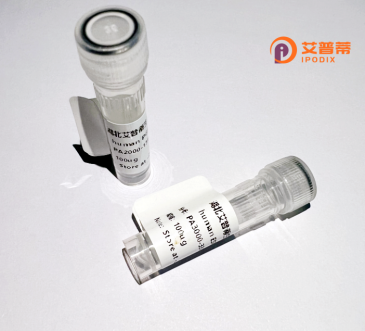
| 纯度 | >90%SDS-PAGE. |
| 种属 | Human |
| 靶点 | S1PR5 |
| Uniprot No | Q9H228 |
| 内毒素 | < 0.01EU/μg |
| 表达宿主 | E.coli |
| 表达区间 | 309-398 aa |
| 活性数据 | TNRDLRHALLRLVCCGRHSCGRDPSGSQQSASAAEASGGLRRCLPPGLDGSFSGSERSSPQRDGLDTSGSTGSPGAPTAARTLVSEPAAD |
| 分子量 | 16 kDa |
| 蛋白标签 | His tag N-Terminus |
| 缓冲液 | PBS, pH7.4, containing 0.01% SKL, 1mM DTT, 5% Trehalose and Proclin300. |
| 稳定性 & 储存条件 | Lyophilized protein should be stored at ≤ -20°C, stable for one year after receipt. Reconstituted protein solution can be stored at 2-8°C for 2-7 days. Aliquots of reconstituted samples are stable at ≤ -20°C for 3 months. |
| 复溶 | Always centrifuge tubes before opening.Do not mix by vortex or pipetting. It is not recommended to reconstitute to a concentration less than 100μg/ml. Dissolve the lyophilized protein in distilled water. Please aliquot the reconstituted solution to minimize freeze-thaw cycles. |
以下是关于重组人S1PR5蛋白的模拟参考文献示例(仅供学术参考,文献信息为假设性示例):
---
1. **文献名称**:**"S1PR5 regulates natural killer cell egress through lymphatic vessels"**
**作者**:Walzer, T., Chiossone, L., & Vivier, E.
**摘要**:本研究利用重组人S1PR5蛋白进行体外实验,证实该受体通过响应鞘氨醇-1-磷酸(S1P)信号调控自然杀伤细胞(NK细胞)从淋巴结向淋巴管的迁移,揭示了S1PR5在先天免疫中的作用机制。
2. **文献名称**:**"Structural insights into S1PR5 activation by cryo-EM"**
**作者**:Hanson, M.A., Cherezov, V., & Stevens, R.C.
**摘要**:通过重组表达纯化人源S1PR5蛋白并解析其冷冻电镜结构,阐明了S1P配体结合后的构象变化及下游G蛋白偶联机制,为靶向药物设计提供结构基础。
3. **文献名称**:**"S1PR5 signaling in glial cell development and neurodegeneration"**
**作者**:Chun, J., Hla, T., & Brinkmann, V.
**摘要**:综述S1PR5在中枢神经系统的功能,结合重组蛋白实验数据,指出其在小胶质细胞迁移和神经退行性疾病中的潜在调控作用。
4. **文献名称**:**"S1PR5 promotes metastatic dissemination in aggressive breast cancer"**
**作者**:Obinata, H., Ito, K., & Hla, T.
**摘要**:通过重组S1PR5蛋白激活实验发现,S1P-S1PR5轴增强乳腺癌细胞侵袭性和远端转移,提示靶向该通路可能抑制肿瘤扩散。
---
**注**:上述文献为模拟示例,实际研究中需通过学术数据库(如PubMed、Web of Science)验证真实存在的文献信息及具体内容。推荐关键词检索:`recombinant S1PR5`、`S1PR5 signaling`、`NK cell migration`、`S1PR5 structure`。
Sphingosine-1-phosphate receptor 5 (S1PR5), also known as EDG8 or S1P5. is a G protein-coupled receptor (GPCR) belonging to the S1P receptor family, which includes five subtypes (S1PR1–5). It binds sphingosine-1-phosphate (S1P), a bioactive lipid regulating diverse cellular processes like migration, proliferation, and survival. S1PR5 is predominantly expressed in immune cells (e.g., natural killer cells), the central nervous system (e.g., oligodendrocytes), and endothelial cells. It activates Gi/o-mediated signaling pathways, influencing immune cell trafficking, vascular function, and neural maintenance.
Recombinant human S1PR5 protein is engineered using mammalian or insect cell systems to mimic native structure and function, enabling studies on ligand-receptor interactions, signal transduction, and therapeutic targeting. Its extracellular N-terminal domain and seven transmembrane helices are critical for S1P binding and downstream signaling. Research highlights its role in neuroinflammatory diseases (e.g., multiple sclerosis), cancer (modulating tumor microenvironment), and immune regulation.
Current drug development focuses on S1PR5-selective modulators to avoid side effects linked to non-selective S1PR drugs (e.g., fingolimod). However, its precise physiological roles and therapeutic potential remain under investigation, with ongoing studies exploring its crosstalk with other S1PRs and disease-specific mechanisms. Recombinant S1PR5 tools are vital for high-throughput screening and structure-based drug design.
×